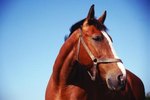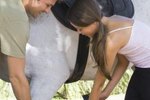
Every horse has a hair swirl, or whorl, somewhere on his face. You might know the pattern by its various nicknames, including cowlick or crown, or by its scientific name, trichoglyph. According to legend, the swirl's pattern portends equine personality traits -- sort of like phrenology for ponies. Now researchers are coming up with their own theories about the equine swirl based on actual studies.
Types of Swirls
Strictly speaking, a swirl occurs whenever the hair starts growing in the opposite direction. Some horses have more than one swirl on the face. Many horses have a swirl between their eyes, while others have them lower on their faces. Swirls also occur on other parts of the body. No matter how large or small or the number on the animal, each one is unique, the equivalent of an equine fingerprint for identification purposes. For that reason, many registries use them as identifying marks on horses' paperwork.
Legend
According to the Australian equine publication Horsewyse, the Bedouins held many beliefs regarding swirls on their beloved Arab horses. These include the good and the bad. For example, a chest whorl indicates prosperity, but a cheek whorl means ruin. More common general beliefs regarding whorls include low facial whorls as a sign of intelligence; the between-the-eyes whorl indicates obedience and a good disposition; left-sided facial whorls mean complications, while right-sided whorls indicate uncooperative, untrustworthy animals. Supposedly, you hit the jackpot if your horse has a long facial swirl, known as the feather mark. These horses are very friendly and love people.
Manageability
In a Polish study conducted in 2006, researchers analyzed 55 2-year old Konik horses, recording whether the number and location of facial whorls. Locations were denoted as above the eyes, or high; between the eyes, or medium and below the eyes, or low. Horses were scored on manageability, including ease of lifting legs for hoof cleaning and leading, along with their startle response and investigation of new items. Researchers reported that horses with high swirls were more difficult to manage than those with medium or lower swirls. There was no difference related to swirls in the startle response.
Motor Laterality
Researchers at Ireland's University of Limerick conducted a study on the relationship between swirls and equine motor laterality. That's science jargon for handedness in people and sidedness in horses. The study found that there was a statistically significant association between motor behavior and facial hair whorl patterns in the horses. Those horses demonstrating more right sidedness tended to have swirls going clockwise, while the left-leaning equines had more counter-clockwise swirls. The study comprised 219 horses, of which 104 equines preferred the left, 95 the right and 20 were "well-balanced," showing no preference for either side during ridden work.
References
- Horse and Rider: Horse Hair -- Whorl Patterns
- Horsewyse: Around the Whorl
- Horse Science News: Hair Reveals Horse Temperament
- Equine Science Update: Whorl Position and Temperament
- National Center for Biotechnology Information: Facial Hair Whorls (Trichoglyphs) and the Incidence of Motor Laterality in the Horse.
Photo Credits
-
David De Lossy/Photodisc/Getty Images
Writer Bio
Jane Meggitt has been a writer for more than 20 years. In addition to reporting for a major newspaper chain, she has been published in "Horse News," "Suburban Classic," "Hoof Beats," "Equine Journal" and other publications. She has a Bachelor of Arts in English from New York University and an Associate of Arts from the American Academy of Dramatics Arts, New York City.




